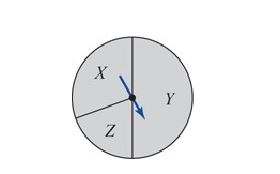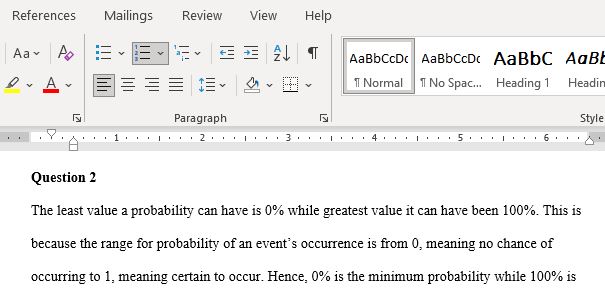A Probability Is a Fraction of a Number of Repetitions of Some Process. What Is the Least Value A Probability Can Have as A Percent
Title: A Probability Is a Fraction of a Number of Repetitions of Some Process. What Is the Least Value A Probability Can Have as A Percent
Learning Exercises for Section 27.1
2. Because a probability is a fraction of a number of repetitions of some process, what is the least value a probability can have, as a percent? What is the greatest value it can have, as a percent? Explain your thinking.
5 a. Describe an experiment involving a toss of 3 dice.
b. Describe an outcome of this experiment.
c. Describe an event related to the outcome of the experiment.
d. List the outcomes that would be in the event, a sum of 5 for the dots showing on the dice.
6 a. Describe an experiment of the drawing of three cards from a deck of cards from which the jacks, queens, and kings have been removed. (Nore: There are 52 cards in a deck— 13 cards are hearts, 13 cards are diamonds, 13 cards are clubs, and 13 cards are spades. A card with an ace count as 1. Nine cards of each suit are marked 2 through 10. Ignore the jacks, queens, and kings, leaving
40 cards from which to draw.)
b. Is drawing a 3 of hearts, a 4 of diamonds, and a 5 of spades an outcome or an event? Why?
c. Is the drawing of three cards whose numbers add to 10 an outcome or an event? Why?
Learning Exercises for Section 27.2
3. Answer the question in each situation.
a. A medical journal reports that if certain symptoms are present, the probability of having a particular disease is 90%. What does that percentage mean?
b. A weather reporter says that the chance of rain is 80%. What does that percentage tell you?
c. Suppose the weather reporter says that the chance of rain is 50%. Does that percentage mean that the reporter does not know whether it will rain or not?
9. Give the sample space for each spinner experiment shown below, and give the theoretical probability for each outcome. How did you determine your theoretical probabilities? In this problem and others with drawings, assume that the angle sizes are as they appear: 900 , 600 , 450 , etc. Recall that the sum of all the angles at the center of a circle must equal 3600
e. Would your answers change if these were dartboards? (You are throwing blindfolded and the throw doesn’t count unless you hit the board.)
12. Consider the spinner shown at right in which the angle forming sector X is 1200 . What is the theoretical probability of the following outcomes?
a. Getting X
b. nor getting X
c. getting Y or X
d. Getting Y and Z (simultaneously)
e. getting Z
f. nor getting Z
15. Make sketches that match the following descriptions. Give the angle sizes of the regions.
a. A spinner with five equally likely outcomes. (How could you do this accurately?)
b. A spinner with five outcomes of which four outcomes are equally likely. The fifth outcome has a probability twice that of each of the others.
c. A spinner with five outcomes of which three outcomes have the same probabilities, and the found and fifth outcomes each have the same probability that is 3 times the probability of each of the first three outcomes.
d. Two spinners that could be used to practice the basic multiplication facts from 0 x 0 through 9 x 9. (Is each fact equally likely to be practiced with your spinners?)
e. Two spinners that could be used to practice the “bigger’ basic multiplication facts, from 5 x through 9 x 9.
Answer Preview For A Probability Is a Fraction of a Number of Repetitions of Some Process. What Is the Least Value A Probability Can Have as A Percent
Access the full answer containing 411 words by clicking the below purchase button




